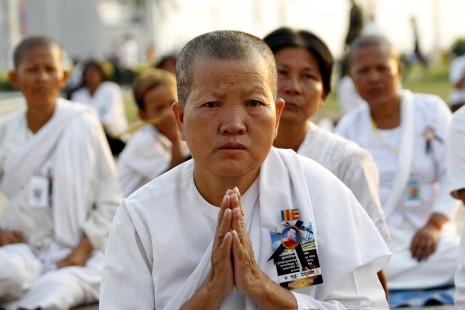Keo Sovan Mony journeyed from Preah Vihear province to Phnom Penh to welcome King Father Norodom Sihanouk’s body back to Cambodia on October 17. But unlike the hundreds of thousands of mourners who joined her in the capital 110 days ago, the 68-year-old Buddhist nun never left.

She has been camping out in front of the Royal Palace ever since.
Each morning for the past three and a half months, Keo Sovan Mony has woken up in her cardboard bed on the grass in front of the Royal Palace, tucked her few provisions into a plastic bag, and begun another day of mourning.
In her white robes, Keo Sovan Mony would sit on a blanket or plastic bag in front of the massive portrait of the late King Father on the palace wall and pray alongside fellow mourners—mostly elderly women—with their hands folded in their laps or pressed together resting on their chests.
When the sun came up over the Tonle Sap and the heat settled in, she would retreat to a shady place under a tree until dusk, when she would return to prayer in front of the palace.
In many ways, Keo Sovan Mony incarnates the sheer display of adoration the Cambodian people have shown for Norodom Sihanouk since his body was returned to Phnom Penh from Beijing, where he died of heart failure on October 15.
“There has never been a king with a heart like his. He helped many poor people and saved our country,” she said yesterday as she sat nearby the Royal Palace.
When Keo Sovan Mony first began her mourning routine, thousands joined her. But as time went by, the number of mourners dwindled to less than 100 each day. She estimated that about 15 other nuns lived with her throughout the 110-day mourning period.
Keo Sovan Mony heard of the late King Father’s death at her pagoda in Preah Vihear. “We felt shock and it was unbearable to accept that it was true,” she said. The next morning, she was in a taxi to Phnom Penh.
Keo Sovan Mony is from a generation that saw many of its peers killed by the Khmer Rouge—she lost 11 family members under the brutal regime. But she remembers fondly Norodom Sihanouk’s Cambodia of the 1950s and 1960s.
“King Sihanouk provided free schools, created factories and provided free hospital services for the poor. So that is why many old people loved him and are now praying for him,” she said.
When Keo Sovan Mony was young, she remembers then-Prince Sihanouk visiting her village in Siem Reap province to donate money and food to poor villagers.
“The king always came to help people when they had disasters or droughts in the provinces,” she said.
Over the past few months, Keo Sovan Mony has relied on the good will and generosity of volunteers in Phnom Penh who were seemingly inspired to follow in the late king’s footsteps.
Each day, people from NGOs, youth groups, private companies or universities would visit Ms. Sovan Mony and her fellow mourners to distribute water, rice and bread.
The most difficult times for Keo Sovan Mony were when it rained. Makeshift beds would be soaked at night and it was impossible to stay dry during the day.
“Even when the rain came and the water filled the ground and made me wet I stayed there,” she said.
Keo Sovan Mony stuck it out and said the real reason she came to the capital was to ask the late King Father to continue watching over the country after his death.
“Although the King Father passed away, we pray for him to look after our people and make our Prime Minister Hun Sen respect our people,” she said.
“Our government does not notice our suffering. Many people do not have homes to stay in. The powerful hurt the poor people and the king has to be here to take care of the country,” she added.



